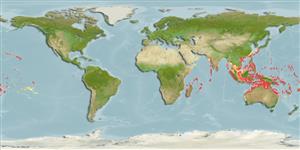>
Holocentriformes (Squirrelfishes, soldierfishes) >
Holocentridae (Squirrelfishes, soldierfishes) > Myripristinae
Etymology: Myripristis: Greek, myros, -ou = male of morey eel + Greek, pristis = saw (Ref. 45335).
More on author: Valenciennes.
Environment: milieu / climate zone / depth range / distribution range
Ecologia
marinhas associadas(os) a recifes; intervalo de profundidade 0 - 100 m (Ref. 128797). Tropical; 32°N - 32°S
Indo-Pacific: East Africa south to Natal, South Africa (except Red Sea, Gulf of Aden, Persian Gulf, Indian coast) and east to French Polynesia and the Hawaiian Islands; north to Tosa Bay, Shikoku (Japan), south to the Great Barrier Reef and Lord Howe Island.
Tamanho / Peso / Idade
Maturity: Lm ? range ? - ? cm
Max length : 26.0 cm TL macho/indeterminado; (Ref. 48635); common length : 16.0 cm TL macho/indeterminado; (Ref. 30573)
Espinhos dorsais (total) : 11; Raios dorsais (total) : 15 - 17; Espinhos anais: 4; Raios anais : 14 - 16. Body red dorsally, silvery pink below LL; reddish brown bar from upper end of gill opening to base of pectoral fins; fins red except for spinous dorsal which is translucent red basally and broadly yellow distally (Ref. 4201). Has smaller scales than most other similar species and the higher number along the body is quite obvious (Ref. 48635).
Lives in subtidal reef flats, also in lagoon and seaward reefs below the surge zone to depths of at least 26 m. Often occurs in large aggregations during the day in areas of rich foliaceous or cavernous coral growth (Ref. 30573). Benthopelagic (Ref. 58302). Feeds on plankton such as crab larvae. Caught at night (Ref. 30573).
Ciclo de vida ou comportamento de acasalamento
Maturidade | Reprodução | Desova | Ovos | Fecundidade | Larvas
Randall, J.E. and D.W. Greenfield, 1996. Revision of the Indo-Pacific holocentrid fishes of the genus Myripristis, with descriptions of three new species. Indo-Pac. Fish. (25):61 p. (Ref. 12419)
Status na Lista Vermelha da UICN (Ref. 130435: Version 2024-2)
Ameaça para os humanos
Harmless
Uso pelos humanos
Pescarias: pouco comercial; Aquário: Espécies comerciais
Ferramentas
Relatórios especiais
Baixar XML
Fontes da internet
Estimates based on models
Preferred temperature (Ref.
123201): 25.2 - 28.9, mean 27.8 °C (based on 640 cells).
Índice de diversidade filogenética (Ref.
82804): PD
50 = 0.5000 [Uniqueness, from 0.5 = low to 2.0 = high].
Bayesian length-weight: a=0.02188 (0.01308 - 0.03660), b=3.12 (2.98 - 3.26), in cm total length, based on LWR estimates for this species & Genus-body shape (Ref.
93245).
Nível Trófico (Ref.
69278): 3.4 ±0.2 se; based on diet studies.
Resiliência (Ref.
120179): Elevada, tempo mínimo de duplicação da população menor que 15 meses (Preliminary K or Fecundity.).
Fishing Vulnerability (Ref.
59153): Low vulnerability (16 of 100).
Nutrients (Ref.
124155): Calcium = 61.3 [29.6, 188.9] mg/100g; Iron = 0.783 [0.335, 1.616] mg/100g; Protein = 18.3 [17.2, 19.5] %; Omega3 = 0.162 [0.067, 0.375] g/100g; Selenium = 35.4 [21.0, 65.2] μg/100g; VitaminA = 108 [42, 272] μg/100g; Zinc = 1.26 [0.81, 1.90] mg/100g (wet weight);
